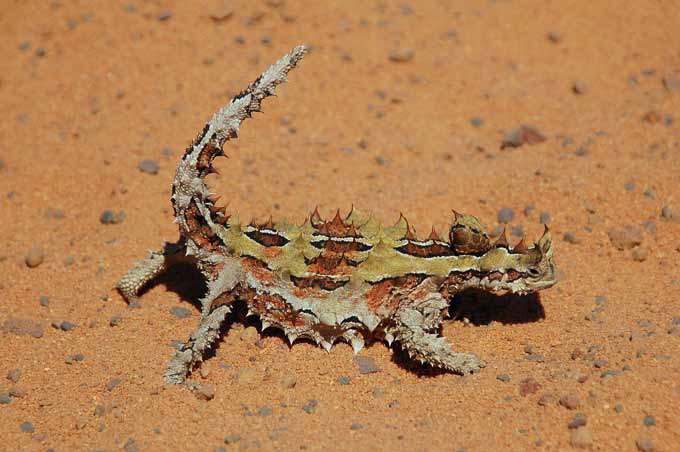|
| 질의: desert horned lizard | 결과: 19번째/25 | |
Thorny Devil (Moloch horridus) - Wiki
| 제목: | Thorny Devil (Moloch horridus) - Wiki
| |

| 해상도: 680x452
파일크기: 80572 Bytes
촬영일: 2007:09:01 20:21:26
등록시간: 2007:09:01 20:24:29
|
ERROR : Server Busy(-1105)
ERROR : Server Busy(-1105)
Thorny Devil (Moloch horridus) - Wiki
Thorny Devil
From Wikipedia, the free encyclopedia
[Photo] Thorny Devil in Kalbarri National Park, Australia (Photo du moloch h??riss??).
Source http://www.flickr.com/photos/wouterdb/267521096/ Date October 7th, 2006. Author Wouter!
Appearance
The thorny devil grows up to ca. 20 cm in length, which is approximately 8 inches, coloured in camouflaging shades of desert browns and tans (colours changing from pale when warm, to darker colours when cold), and is entirely covered with conical spines (mostly uncalcified). It also features a spiny "false-head" on the back of the neck, which predators might eat instead of the real head of the thorny devil. Females are larger than males.
Habitat
It inhabits arid scrub and desert over most of central Australia. In particular, it inhabits spinifex-sandplain and sandridge desert within the interior and mallee belt. Its distribution largely coincides more with the distribution of sandy and sandy loam soils than with a particular climate (Pianka and Pianka 1970).
Diet
The food that the devil mainly eats is ants, often Iridomyrmex. They can eat over 5,000 ants in one sitting. They collect moisture in the dry desert via night-time condensation of dew which forms on the skin and is channelled to the mouth in hygroscopic grooves between its spines (Bentley and Blumer 1962), and also during rain events.
A clutch of three to ten eggs is laid in September-December (spring-summer) in a nesting burrow about 30 cm underground, and hatches after an incubation of three to four months (Pianka 1997).
Predators include bustards and goannas.
The thorny devil is only distantly related to the morphologically similar North American horned lizards of the genus Phrynosoma, and is more an example of convergent evolution.
http://en.wikipedia.org/wiki/Thorny_Devil
| The text in this page is based on the copyrighted Wikipedia article shown in above URL. It is used under the GNU Free Documentation License. You may redistribute it, verbatim or modified, providing that you comply with the terms of the GFDL. |
|
댓글 |
|---|
| | 손님 |
|
| i want more info |
| | 손님 |
|
| me too!!!!!!! AAHHH ITS SOOO ADORABLE :P |
| | 손님 |
|
| more info. this isnt enough |
| | 손님 |
|
Moloch horridus
Thorny Devil, Thorny Dragon, Thorny Lizard
Thorny devils are well-known for the many, large spines on their bodies. Their large spines are entirely boneless, only two parietal spines are supported by modest bony bosses on the skull. Their bodies are covered with thick shields and spiny cones and they are marked with golden and brown patches that serve to camouflage them in their arid habitats. They are extremely difficult to find because of their camouflage and escape detection even at close quarters and with experts who are actively looking for them. |

|

|

|
desert horned lizard
19/25 |

|
 |
^o^
동물그림창고 똑똑전화 누리집
^o^
|
|
|